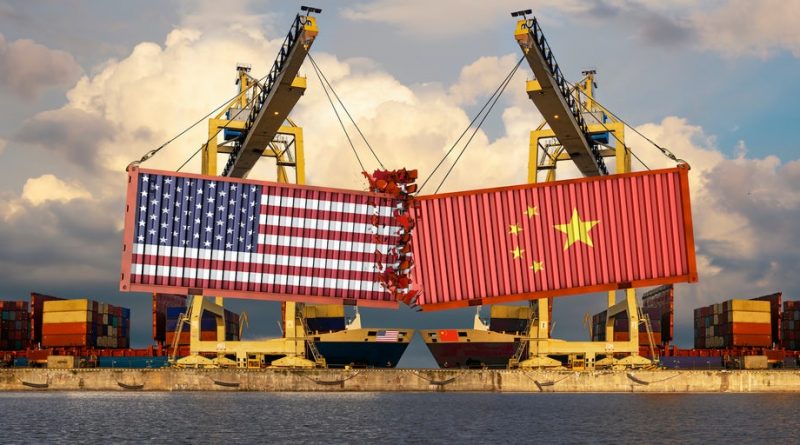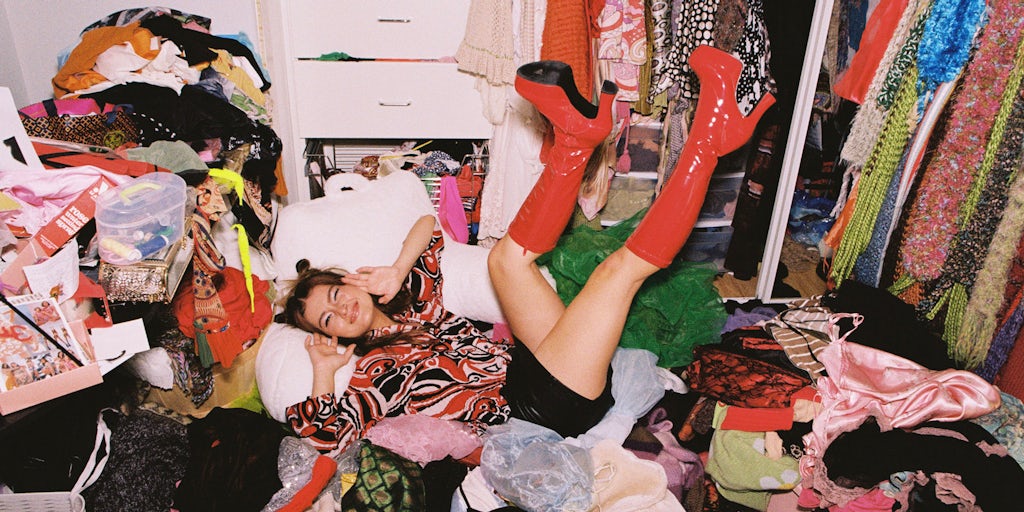Which Brands Will Suffer Most in the ‘New Cold War’ Between China and the US? | BoF Professional, China Decoded
SHANGHAI, China — The relationship between the world’s two largest economies is at one of its lowest ebbs in history. With little more than 60 days from the US presidential election, the timing of this “New Cold War” — as it is now being described in earnest — has brought the conflict into even sharper focus.
In the half century since China and the US re-established official diplomatic relations, the two countries have certainly had their differences. But in 2020, these cracks have not only multiplied, they have become chasms.
On issues as varied as trade, technology, Hong Kong’s national security law, Taiwan’s future, territorial rights in the South China Sea and human rights in Xinjiang, China’s more assertive foreign policy posture — referred to frequently as “Wolf Warrior diplomacy,” in a nod to a wildly popular Chinese action film series — has clashed with the hawkish stance of the Trump administration to scuttle any chance of improving what is arguably the world’s most important bilateral relationship.
The US-China relationship will determine the fate of a slew of many US apparel and footwear businesses.
Companies are understandably fed up by the layers of complication this geopolitical rift keeps piling on, both in terms of the added costs of doing business, as well as additional compliance measures and a general unsettling miasma of uncertainty about what the future might hold.
As American Apparel and Footwear Association President Steve Lamar points out, absorbing these layers of cost and complexity would be difficult enough in the best of times, but now is hardly the best of times.
“When you are dealing with this unprecedented, existential crisis like Covid-19, [then complying with the added tariffs and sanctions that have been put in place it] is an extraordinarily difficult undertaking,” he said.
Worst of all, for the individuals and businesses living with the precariousness that this conflict brings, a victory for Joe Biden in the upcoming presidential election would not change much, according to most mainstream analysts.
As the Economist Intelligence Unit surmised in a recent report about the future of the US-China relationship under a Biden presidency: “there is little prospect for an improvement in bilateral relations in the coming years.” Even if the conflict were to somehow de-escalate, it would not alter the underlying rivalry between the US and China — one that will continue to grow regardless.
Yet there’s no escaping the fact that the state of the US-China relationship will determine the fate of a slew of companies. This not only includes Chinese tech giants, such as Tencent and Bytedance, but many US apparel and footwear businesses too, who have complex supply chain links in China, and who are also dependent on an increasing proportion of their global revenues from the country.
Take Nike, which earned $6.68 billion in Greater China in its last fiscal year. The market accounts for almost 20 percent of its global sales, as well as 25 percent of the goods it produces. VF Corp., the parent company of North Face, Timberland and Vans, gets approximately 15 percent of its sales and 20 percent of its products from China, according to estimates from Cowen & Co.
As this prolonged and multi-pronged conflict continues to escalate, many companies are struggling to find their feet as the ground seems to continually shift beneath them. But there are some fashion players who are more exposed than others.
High Tech Canaries in the Coal Mine
Technology, data and information are three key elements that have been central to efforts on both the US and China sides to “decouple” from one another in recent years. As a result, technology companies were the first commercial targets of the brewing US-China Cold War.
Consequently, Chinese technology companies have been disproportionately caught in the crossfire because they are more developed in their global ambitions than other sectors. Alibaba, Tencent and Bytedance have achieved such dominance within China that they must look abroad to continue their quest for undiminished growth.
Many companies are struggling to find their feet as the ground seems to continually shift beneath them.
However, earlier this year, the US Senate passed a bill that would require the delisting of any company on a US stock exchange that goes three consecutive years without being inspected by the Public Company Accounting Oversight Board (PCAOB). Meeting this requirement is a virtual impossibility for US-listed Chinese tech giants such as Alibaba, JD.com, Pinduoduo, Secoo and Bilibili because the Chinese Government believes PCAOB inspection of Chinese audit records would violate state secrecy laws, putting them in a bind.
This matters to US fashion and beauty brands because they are more intertwined than ever with Chinese tech giants whose e-commerce and social platforms are used by brands to sell and market their goods to Chinese consumers.
More recently, President Trump announced executive orders that would force Chinese platforms WeChat (owned by Tencent) and TikTok to sell their US operations or risk being unable to transact with US users, companies or other broadly defined “entities” after a September 15 deadline.
Bytedance, which owns TikTok and Douyin, is now under immense pressure to sell off its US business (unconventional suitors such as Microsoft, Walmart and Oracle have all come calling), but in a new twist, China’s Ministry of Commerce just updated its list of “forbidden and restricted technology exports” to include, among many other things, “personalised information recommendation services based on data analysis” — in other words, precisely the kind of algorithm that has driven TikTok’s success.
This means that any sale would need Beijing’s approval, taking time that Bytedance doesn’t appear to have.
A TikTok shutdown in the US would be an annoyance to fashion marketers from brands including Gucci, Balmain and Balenciaga who have recently jumped aboard the platform partly in order to reach its 100 million-strong, predominantly Gen-Z user base in the US market, but of greater concern to many more brands is the prospect of being cut off from WeChat.
US fashion and beauty brands are more intertwined than ever with Chinese tech giants.
US fashion brands such as Coach or Michael Kors may also be limited in their abilities to communicate with and sell to the world’s largest fashion consumer market, but it’s not just luxury players who rely on WeChat. Retailers such as Walmart, which derives 9 percent of global revenue from China, say they would see a significant decline without the WeChat eco-system, through which it processes at least 30 percent of its transactions in the mainland.
“When the administration talks about banning WeChat, they are really focused on… privacy and whatever control they believe the Chinese government has on that platform, but there doesn’t seem to be a deeper [consideration] of the way in which American businesses depend on WeChat for their communications in China and other parts of the world. Or, more importantly, the extent to which American businesses depend on China to make sales in China,” Lamar said.
Supply Chain Costs Increase
Even before the current conflict ensnared technologies that US fashion brands have become increasingly reliant on, manufacturing in China — which US fashion brands have long been reliant on too — was already a flashpoint.
Unlike American fashion brands who routinely source from, manufacture in and sell to China, the same cannot be said of Chinese fashion companies that are more likely to be focussed on the domestic market. Consequently, US players arguably have more at stake than their Chinese counterparts.
A tit-for-tat tariff escalation — that saw virtually all apparel and footwear made in China for US consumption subject to higher taxes than before the US-China trade dispute began — accelerated the process of offshoring from China for many US brands. Levi’s, for example, by 2019 had trimmed its Chinese manufacturing to just 1 to 2 percent of its product sold in the US, compared to 16 percent two years earlier.
The signing of a “phase one” trade deal in January may have halted that particular escalation, but it didn’t eliminate many of the increased tariffs on apparel and footwear put in place over the course of the trade war.
Shoe companies remain heavily reliant on China for manufacturing, in particular brands like Steve Madden and Skechers. Last year, Steve Madden Chief Executive Edward Rosenfeld said the company still manufactures 85 percent of its products in China, and even ongoing efforts to diversify probably wouldn’t push that number below 60 percent in the near-term.
The trade war isn’t the only factor impacting fashion brands that source from China. In July, the US government advised organisations to monitor their supply chains for risks related to Xinjiang, including those involving facilities outside of Xinjiang that use labour or goods from the region. Given Xinjiang’s importance as a global source for cotton (it supplies at least three-quarters of China’s cotton and China is the number one source of cotton in the world) as well as China’s importance as a textile sourcing and apparel manufacturing hub, this directive implicates many more fashion brands than meets the eye.
The political narratives [are] easy to understand, but understanding the longer term economic impact is more difficult.
For instance, Changji Esquel Textile Co., is one of 11 companies specifically named by the US government as subject to these sanctions. The Hong Kong-based textile manufacturer with 40,000 employees at factories in China, Vietnam and Sri Lanka is known to have supplied US companies Ralph Lauren and Brooks Brothers, as well as international fashion retailers Hugo Boss and Lacoste with apparel to be sold in their US stores.
“The political narratives [are] easy to understand, but understanding the longer term economic impact is more difficult,” Lamar said.
“Overlay that with what we’re going through as a result of Covid-19 and… it becomes even more difficult to comply and the political appetite to take these actions becomes even greater,” he added.
Is There A Silver Lining?
Though the relationship between China and the US has certainly deteriorated this year, China’s ‘Wolf Warrior’ foreign policy has also contributed to the country’s deteriorating relationships with India, the UK, Australia, Canada and others, for varying reasons.
As long as there have been diplomatic or geopolitical tensions between China and other countries (Japan, Korea, France, and others have been at odds in the recent past) there have been questions about how government-level conflicts impact the appetite of Chinese consumers to buy brands from those countries.
So far, Chinese consumers have demonstrated that any impact tends to be minimal, and short-lived, with consumer priorities intently focused on buying the best quality items they can afford, that best suit their lifestyle.
“Chinese consumers are pragmatic, they have learned to separate the brands they consume with the countries behind those brands,” explained Jason Yu, Greater China general manager of Kantar Worldpanel.
Chinese consumers are pragmatic, they have learned to separate the brands they consume with the countries behind those brands.
Even when Chinese consumers say they would boycott products for patriotic reasons, many don’t actually put their money where their mouth is.
Just before last year’s Singles’ Day festival, a survey released by global consulting firm AlixPartners found around 80 percent of Chinese shoppers said they would boycott American brands during the shopping festival, citing “patriotism” as the major reason. When the time came to open their wallets, however, it was a different story.
Major Singles’ Day winners on Alibaba’s platforms included American brands Nike and Estée Lauder, which each topped 100 million yuan ($14.64 million) in sales over the course of the festival. The US also ranked as the second-biggest source of products overall, behind only Japan (also no stranger to geopolitical conflict with China).
So, if patriotism-fuelled boycotts are not the next major threat, then what is? Given the pace at which relations between China and the US have deteriorated in recent years, there is a highly unlikely but not inconceivable scenario left to deploy from the Chinese arsenal.
Kantar’s Yu says the real nightmare for US brands would be if the Chinese government looked to punish American businesses by leaning on tech giants Alibaba, Tencent and JD.com to halt or thwart their relationships with American businesses, essentially cutting off access to large swaths of the country’s 1.4 billion consumers.
Barring such an extreme future outcome, Yu says brands can play a part in protecting their interests in the Chinese market.
“As long as brands don’t get [directly] involved in these conflicts and continue to serve their [Chinese] customers, providing the best quality products to them, in the long term they will be unaffected by geopolitical tensions,” Yu said. “Because [ultimately] Chinese consumers [simply] want to buy high quality good from foreign countries.”
“That trend isn’t going backwards; it’s only going to get more [pronounced] moving forwards.”
时尚与美容
FASHION & BEAUTY
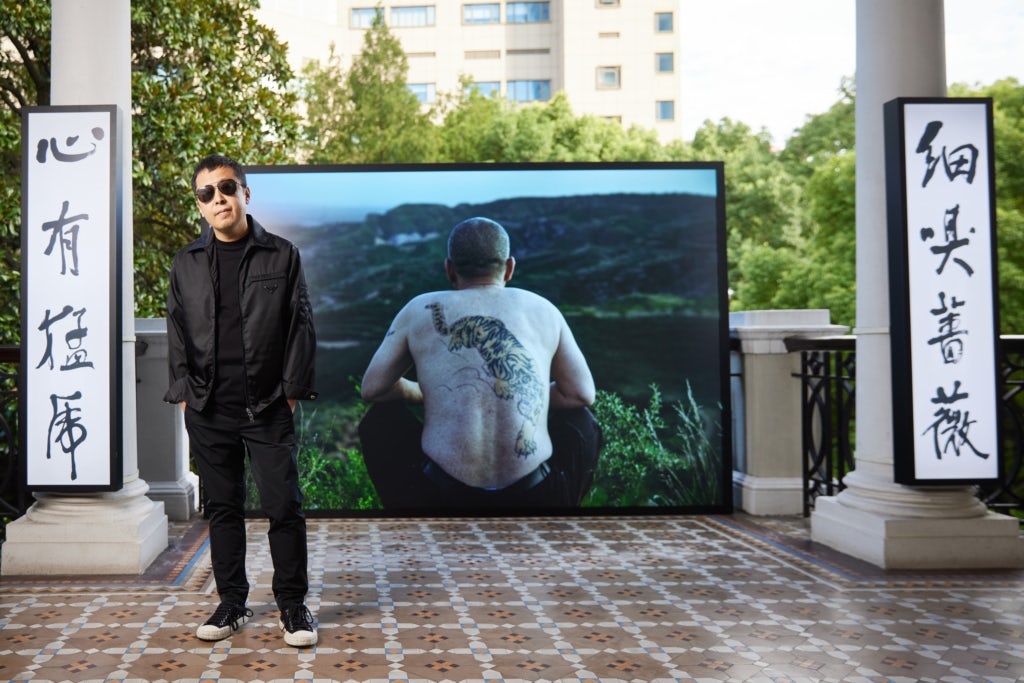
Film director Jia Zhangke poses beside his works on display as part of the Prada Mode Shanghai Culture Club | Source: Courtesy
Prada Mode Culture Club Lands in Shanghai
The fashion world’s biggest names continue their return to physical events in China, with Prada bringing its Prada Mode Culture Club concept to Shanghai this week, it’s fifth global destination. In typical Prada style, it was culture, aesthetics and creativity that were the focus of the event, held at the brand’s restored mansion, Rong Zhai, and attended by more than 2,000 invitees. Chinese film director Jia Zhangke presented a special film and photographic exhibition and took part in a series of talks with poets, writers and architecture professors that examined the intersection of creativity, culture and humanity. Unlike previous editions of the Prada Mode Culture Club, this one was came complete with its own WeChat mini-programme and saw events live-broadcasted.
Fashion Zoo Returns, Stella McCartney Headlines
Consumer facing fashion fair Fashion Zoo returns to Shanghai Exhibition Centre from September 3 to 6, with fashion shows, talks, art exhibitions, pop-ups and parties. Sustainability is a major theme running through this year’s event and Stella McCartney is headlining with a show on opening night. Other international brands on the schedule include Anna Sui Active and Karl Lagerfeld, the latter brand releasing a collaboration with KFC. It might seem like a strange marriage, but food and beverage collaborations with fashion and beauty brands have emerged as a popular marketing tool in the Chinese market, reliably cutting through to create buzz when executed well. (Official WeChat)
科技与创新
TECH & INNOVATION

Screenshots of videos on Douyin | Collage by BoF
Douyin Ups Ante in E-Commerce Competition
Douyin, China’s version of TikTok, plans to ban links to third-party websites on its livestreaming channels in a move that will prevent merchants from directing traffic to popular e-commerce websites like Alibaba’s Taobao and JD.com. Merchants must also use Douyin’s own digital marketing matching service to find KOLs and can’t promote products from third party e-commerce website via its livestreaming service (though this remains possible for products sold through the app’s short videos). Douyin’s move to build a closed-loop for its livestreaming e-commerce business makes sense for the platform, opening up a potentially lucrative monetisation stream. (South China Morning Post)
Bilibili Invests in Original Programming
Video-streaming platform Bilibili, best known for high-quality user-generated content, is making a move into top-tier entertainment by snapping up almost 10 percent of film and television studio Huanxi Media for $66 million and signing a five-year content partnership that will give Bilibili exclusive online broadcast rights to existing and upcoming Huanxi releases, along with opportunities to jointly develop films and drama series. While the vast majority of content viewed on Bilibili comes from users, the platform has been investing in more original programming, including documentaries, reality shows, and animation, while establishing content partnerships with global networks such as the BBC, National Geographic, and Discovery. (Content Commerce Insider)
消费与零售
CONSUMER & RETAIL
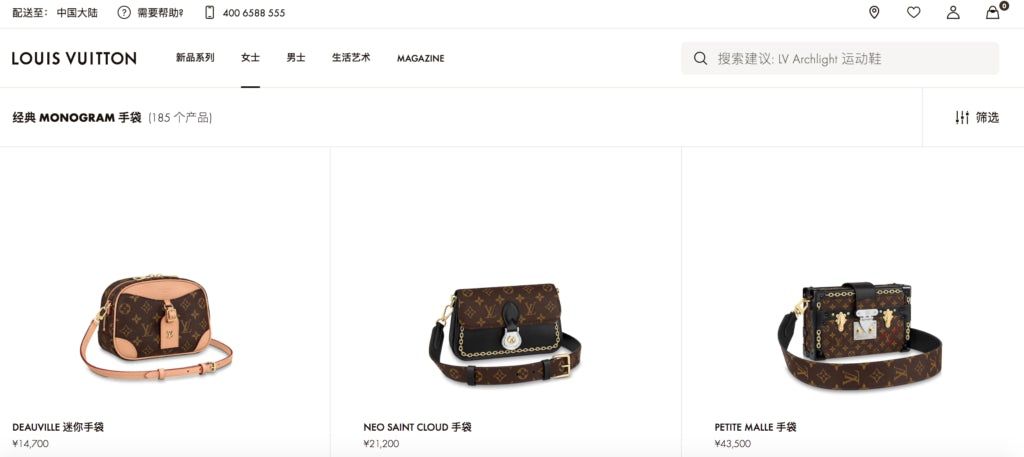
A screenshot of Louis Vuitton bags on the brand’s Chinese website | Source: Courtesy
Counterfeit Ring Aided by Louis Vuitton Shop Assistant Shut Down
Shanghai police have announced a breakthrough in a long-running counterfeit investigation, making 62 arrests related to a gang selling fake Louis Vuitton bags. Police seized raw materials, equipment and more than 2,000 bags as part of a raid targeting a gang it says sold more than 10,000 counterfeit bags, valued at more than 100 million yuan ($14.65 million). According to police, the suspects copied new product styles provided by a Louis Vuitton shop assistant employed at a store in Guangzhou before they went on sale, so the fake bags could be sold simultaneously or even earlier than the real thing. The counterfeiters even built NFC (near-field-communication) microchips into the bags, which linked to Louis Vuitton’s official website when scanned. (CCTV Financial News)
Fast Fashion Retailer C&A Sells China Business to Private Equity Firm
European fast fashion brand C&A has sold its Chinese business to Beijing-based private equity firm Zhongke Tongrong for an undisclosed sum. The brand has 70 stores across China, part of a worldwide network of 1,400 shops. C&A, while being a lower key player than other European fast fashion imports, such as Zara and H&M, has quietly focused its energies on the Chinese market in recent years, at one point announcing plans to roll out hundreds of stores across the country. With the lingering impact of the pandemic and an accelerated shift to e-commerce happening in the Chinese market, it’s likely those plans are on hold for the time being. (Ladymax)
政治,经济与社会
POLITICS, ECONOMY, SOCIETY
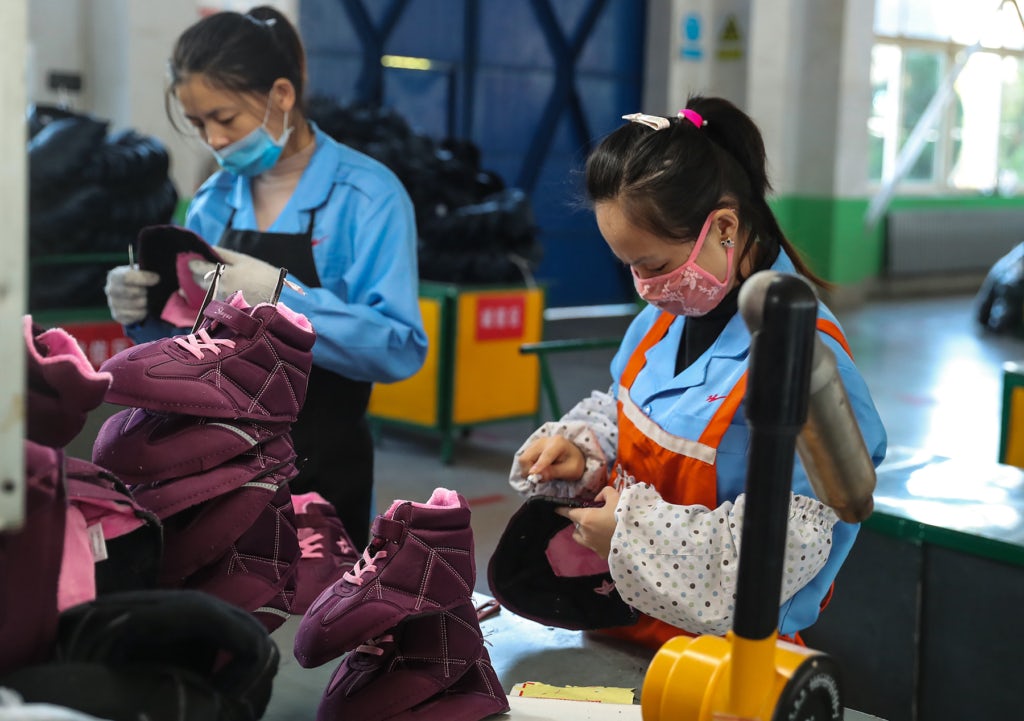
Factory workers in Qingdao in China’s eastern Shandong province | Source: Getty Images
China Posts Strong Economic Data for August
China’s manufacturing activity continued its rapid ascent in August. Caixin’s China general manufacturing purchasing managers’ index (PMI), which gives an independent snapshot of the country’s manufacturing sector, rose to 53.1 compared to 52.8 in July, reaching a high unseen since the start of 2011. Meanwhile, economic data from China’s National Bureau of Statistics (NBS) allayed concerns that the country was experiencing a two-track recovery, in which manufacturing bounces back quickly, but the service sector, including retail, lags amidst continued concern about the pandemic. China’s official non-manufacturing PMI rose to 55.2 in August from 54.2 a month earlier, mainly driven by the service sector, the NBS said. (Caixin / National Bureau Statistics)
Chinese Millennials Embrace the Single Life
The number of singles in China has now surpassed 200 million, according to government data with the total number of people living alone expected to reach 90 million by 2021. A number of restaurants are catering to this demographic by offering single person tables or giant teddy bears as dining companions for those eating alone. Some argue China’s declining birth rate will undermine the country’s long-term growth and in response, authorities have launched a swath of pro-marriage policies, including the introduction of mandatory “cool-off periods” for couples seeking a divorce. There are also those who say singles may be able to give the economy a much-needed boost. Unburdened by expenses like children’s education makes singles more free-spending consumers than their married counterparts. (SixthTone)
China Decoded wants to hear from you. Send tips, suggestions, complaints and compliments to our Shanghai-based Asia Correspondent [email protected].

